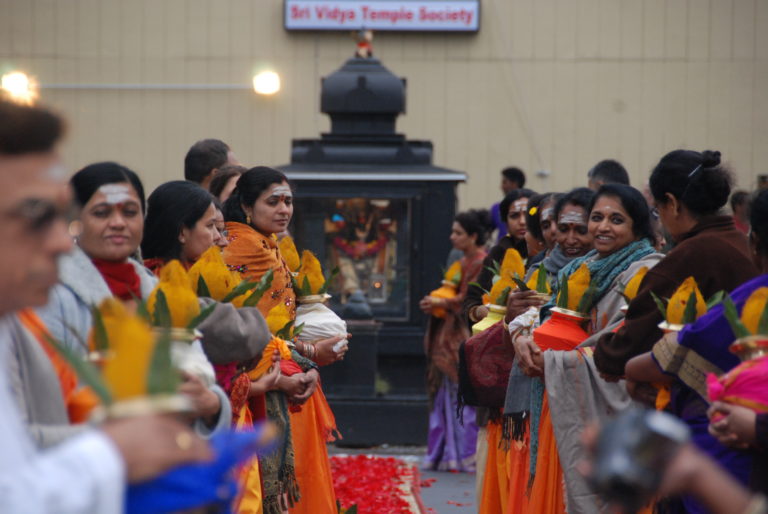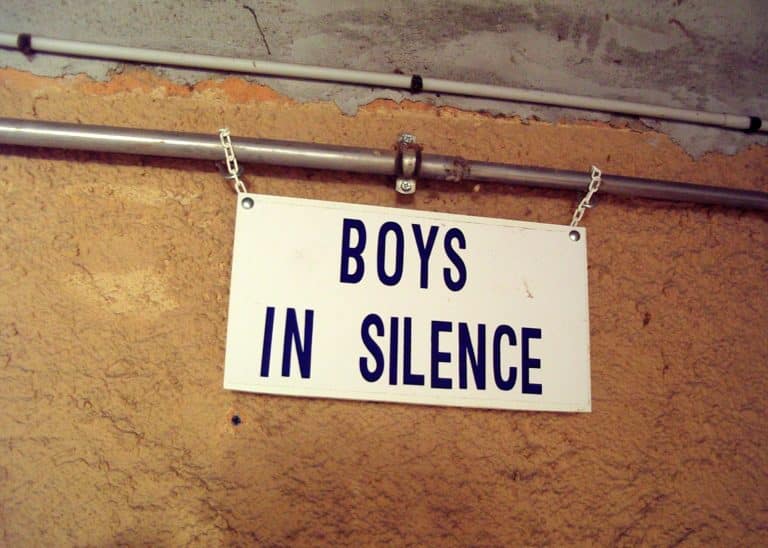
Image by Sri Rajarajeshwari Peetham.
Chanting the World Back Together
It’s still dark when I get up. I usually stay in bed much later, but right now sleep seems much less important than being at the temple. I don’t even wait for the alarm to go off. I fumble an approximation of the correct mudra and whisper “Hamsa Shiva Soham” once before my feet touch the floor, kiss my wife, and pad to the bathroom.
Half an hour later I’m in my car, and 15 minutes later I’m pulling into a middle-school parking lot. I just have time to straighten my dhoti before a Toyota minivan with a sign reading “SVTS Shuttle Service” picks me up. The morning sun brightens over the western New York countryside, its rolling fields especially beautiful in the raking light, and soon we’re turning into the temple driveway.
The scene is like something out of an ancient Indian epic. Drums beat, conchs blare, and hundreds of voices chant in Sanskrit as tens of thousands of offerings are made into sacred fires. But this is not a glimpse into a timeless, unchanging world. The officiants at the fire pits aren’t priests. They’re men and women, both Indian and non-Indian, and only a few wear the sacred thread of the Brahmin caste. This is something both incalculably ancient and radically new.

From the outside, my temple, the Sri Rajarajeshwari Peetham, is a nondescript ranch house and a clutch of prefabricated outbuildings. Inside, though, it’s filled with flower-garlanded figures of the goddess and other deities. Incense and ghee lamps are burning, and the walls are decorated with a kind of mandala made up of rings of triangles. These images, the Sri Chakra, mark the temple as a center for Srividya, a tantra practice from South India.
Tantra is usually associated with sex or transgressive practices. Srividya, though, is as respectable as tantra gets. Yet it remains true to the core of tantra. Its elaborate fire offerings, pujas, and mantra repetitions are meant to bring devotees to experience everyday life as the blissful play of the divine.
Like every other branch of tantra, too, it seeks to harness the creative power of divine energy which for tantrikas is the only reality. The Sri Chakra maps that energy as it flows out from incomprehensible oneness, emerges as the polarity of Shiva and Shakti — the great god and goddess, both separated and inseparable — and passes through division after division until it comes to experience as the world itself.
Tantra has egalitarian tendencies, and in this temple equality is taken seriously. Aiya, the guru — the name is the usual way to address men in Tamil — isn’t a Brahmin, and many of the people he seeks advice from are women. He came to the United States to work as an architect and set up a temple in his garage. Word spread of the richness of the rituals there and the fact that women and men of all castes and backgrounds got to perform them, the temple outgrew its makeshift home, and twelve years ago it was moved to this site and a formal temple building was dedicated.
Every Indian temple has to be purified and renewed every twelve years, but what Aiya has organized goes far beyond the customary rites of purification. It’s a rare and daunting eleven-day offering called the Ati Rudram. At its heart is the Sri Rudram, a litany of salutations and supplications to the god Shiva which is generally considered one of the most powerful and complex of all mantras. (At a decent clip it takes ten to fifteen minutes to recite.)

According to Aiya, reciting the Rudram recreates the energy of the Big Bang. His parallel is quite in keeping with the ancient Indian notion that the world is created out of sound. Mantras don’t name or describe, they make things come into being. Their sound is the shaping activity of divine energy itself, and few mantras are as potent with that energy as the Rudram. Strong enough to begin with, its power is only magnified by fire offerings.
To house the ritual in the problematic upstate weather a huge tent was set up next to the temple. One hundred twenty-one fire pits were built and 1008 metal pots were filled with special liquid, wrapped in cloth, topped with turmeric-dusted cocoanuts, and charged with the presence of different deities. The two largest stand in the center of the tent as Shiva and Shakti, with the others at the fire pits and all around the tent’s sides. They are to absorb the vibrations as on each of eleven days the eleven chapters of the Rudram are chanted eleven times by eleven times eleven chanters and as millions of offerings are made into eleven times eleven fires. On the last day their liquid will be poured over the Goddess in the sanctuary to renew the temple’s life.
I’m not at one of the fires, but this is fine with me. I’d rather focus on the chant than mess with ghee and fiddle with firewood, and the Rudram seems to go deeper on every go-round. Even if you don’t know what the words mean it’s an intense experience. Complexly structured verse gives way to paired phrases and then to paired words. The pace accelerates gradually but unstoppably until it opens up into the expansive verse of the final chapter. Simply negotiating the tongue-twisting Sanskrit for a cycle feels like winding up a coiled spring inside and letting it go.
The words themselves are both perplexing and challenging. Shiva is a strange and difficult figure. He’s contradiction himself, the point where all opposites meet. He is everything and nothing, beyond good and evil, beyond grasping or even thinking about:
Salutations to the trees tufted with green leaves; salutations to the Lord of the cattle.

Salutations to Him who is light yellow-red tinged and radiant; to the Lord of the pathways, salutations. (Translation)
That makes some sense. So does the chant’s list of occupations and objects, since Shiva is manifest in everything there is:
Salutations to you who are in the form of carpenters and fashioners of chariots.
Salutations to you who are in the form of those who mold clay and make mud vessels, and artisans working in the metals.
And yet Shiva is all the things we don’t like, too. We don’t get to pick and choose:
Salutations to Him who stands prominent, the wielder of the sword; to the prince of thieves, salutations.
Salutations to Him who is in the form of swordsmen who wander about at night; to the Lord of those who kill and seize others’ possessions, salutations.
But we can beseech:
Lord Rudra! Afflict not the elders in our midst, nor the tender babe, nor the procreating youth, nor the child in the womb, nor the father or mother, nor our bodies dear to us.
Making offerings into the sacred fire, we shall serve and calm you by our salutations.
Do the words matter? They do and they don’t.
They’re true, but only if you move beyond them to inhabit the wordless place where all words come from. You chant to get past the chanting, and as I do I feel at moments as if I am holding the entire universe in my arms. All of its contrarities, all of my needs and hopes, all of the dangers of the Bronze Age and and the post-nuclear age, the trees and the streams, the large and the small, the fords and the rocks, the thieves and the makers of drums, everything dances in the smoke and fire.

And after the climactic offerings, as the sound of shawms, drums, bells, and conch shells dies away, I see what we’re doing with sudden clarity. The tent is a microcosm. It’s the universe and it’s the Sri Chakra, too. At its center are Shiva and Shakti, the first moment in the dance which flowers into the whole of things, and around them are deities who together encompass every possibility of existence.
In that microcosm we’re chanting a mantra that reaches back to the Big Bang and out to the manifold beauty and terror of our world. This is something more than re-energizing a temple, I realize. We have the privilege of sitting at the heart of things and chanting the world back together. Not only that. It seems to me then that this is what human beings have always done, and it is exactly what we are meant to do.


Share your reflection